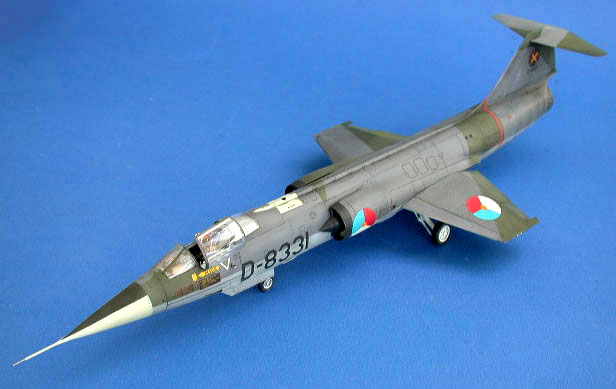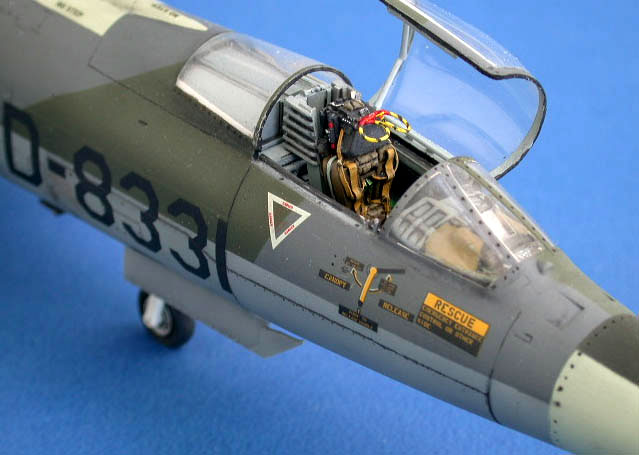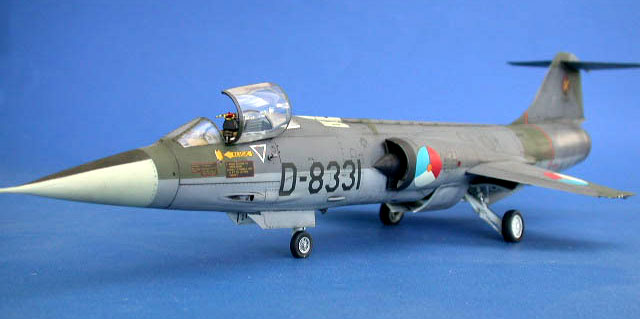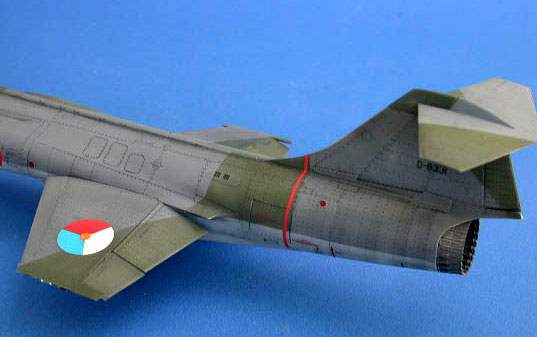|
F-104G
Starfighter
by
Henry Juarez
|

|
|
F-104G Starfighter |

Hasegawa's 1/48
scale F-104G Starfighter is available online from
Squadron.com
This is Hasegawaís 1/48 scale F-104G Starfighter.
Upon first inspection, I noted the usual high standard of fine detail
throughout the kit, including recessed panel lines. However, I was
disappointed in the large number of ejection marks along the underside
of the wings and flaps. All the surface detail underneath the wings made
it especially hard to fill and sand without losing detail.
The kit comes with two wingtip tanks, but no
weapons, as usual. I think Hasegawa does this to all its kits in order
for the consumer to purchase their weapons sets!
Construction began with the addition of the Black
Box (48006) cockpit detail set. This is a highly recommended enhancement
to the kit. The set provides the newer Martin-Baker GQ-7 ejection seat,
which replaced the older Lockheed C-2 seat and is standard with a few
NATO Air Force, F-104ís. Once the cockpit was painted in Model Master
Dark Gull Gray, the sidewalls where installed first, followed by the
cockpit tub. The set goes in without any cutting or modification to the
kit fuselage.

Next came the intake trunks. The intake trunks have to be assembled
before attaching them to the main fuselage. Before they were assembled,
I painted the inside of the intakes white. The inside of the lip and a
portion of the intake splitter cone were then painted flat black. Once
this was completed, I assembled the trunk and attached it to the
fuselage. This is where I had the most problems. The fit here is
somewhat left to be desired. A lot of filling and sanding was required
to get a flush smooth mating surface. This caused a loss of detail in
this area and there was a lot of fine detail here which had to be
re-scribed.
The rest of the plane went together without much trouble. The flaps were
left off until the painting process began, as well as the exhaust can,
which was replaced by the Aires set (4100). This too is one of the
finest castings Iíve seen to date.
I left off the wingtip tanks to show a training and evaluation plane of
the Dutch Air Force.
Painting began with an overall coat of Dark Ghost
Gray. This acted as a primer as well as the underside color. Once this
color was sprayed, I pre-shaded all the panel lines using a thinned
mixture of flat black and dark gray mix. I then sprayed the base color
(dark ghost gray) over the entire underside until just a hint of the
panel shading was visible. Next, I painted the two-tone camouflage of
gunship gray with a little light ghost gray mixed and dark green mixed
with a little forest green. Again, each of these colors was sprayed over
the panel shading until a hint of shading was visible.

Once all the colors were painted on, I lightened the base mixture of
each color. I sprayed the inside of each individual panel until it was
noticeably lighter. Next, I thinned the base color to a ratio of 70%
thinner to 30% base color. I then went over the entire specific color
until I reach a balance between the panel shading and the lightened
panels. This technique is subtle and to each individual taste.
After the model was sprayed and I was satisfied with the tone of colors,
I sprayed the entire model with Future acrylic floor polish. This sealed
the paint and prepared the plane for decaling and weathering.
Once the Future cured for a day, I mixed a wash of
flat black and dark gray with mineral spirits. The entire model then
received this mixture in all the recessed panel lines and detail. The
excess was then wiped off with a dampened soft rag of mineral spirits.
The plane was left to dry for about another day before moving on to
decaling.
The kitís decals were applied with the assistance of Solvaset solution.
Once the decals settled down, I ran a blade over the decal and panel
line and used more Solvaset to get the decal to settle down further. I
ran the wash over the decal/panel line and wiped the excess, as before.

The entire model was then sprayed with Testor's Dullcoat. Once the flat
coat was dry after another day of waiting, I took some artists oils
(Black and Burnt Umber) and lightly dry brushed the aft section of the
exhaust area. Oil streaks around the plane were also replicated using
this mixture.
After all the painting and weathering was finished, I attached the
flaps, exhaust can, canopy and wheels.
Although, the colors may not be right (as I was
later told), I believe the techniques shown here still make for a decent
looking model.
I canít over emphasize what a great resin update Black Box has come up
with for this version. After seeing the quality of the Aires exhaust
can, I ran out and purchased their cockpit set (4098) for the C version
and the wheel well set (4103), and found them equally exceptional.
I hope youíve enjoyed this article. I look forward to your comments.
Click the thumbnails below
to view larger images:
Model, Images and Text Copyright © 2002 by
Henry Juarez
Page Created 22 April, 2002
Last Updated 27 May, 2007
Back to HyperScale
Main Page
Back to
Features Index
|
Home
| What's New |
Features |
Gallery |
Reviews |
Reference |
Forum |
Search